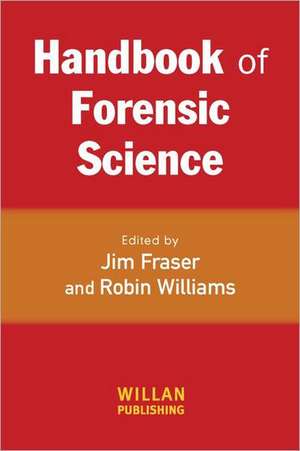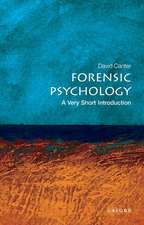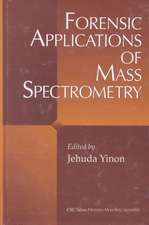Handbook of Forensic Science
Editat de Jim Fraser, Robin Williamsen Limba Engleză Hardback – iul 2009
This Handbook aims to provide an authoritative map of the landscape of forensic science within the criminal justice system of the UK. It sets out the essential features of the subject, covering the disciplinary, technological, organizational and legislative resources that are brought together to make up contemporary forensic science practice.
It is the first full-length publication which reviews forensic science in a wider political, economic, social, technological and legal context, identifying emerging themes on the current status and potential future of forensic science as part of the criminal justice system. With contributions from many of the leading authorities in the field it will be essential reading for both students and practitioners.
| Toate formatele și edițiile | Preț | Express |
|---|---|---|
| Paperback (1) | 384.63 lei 6-8 săpt. | |
| Taylor & Francis – iul 2009 | 384.63 lei 6-8 săpt. | |
| Hardback (1) | 1227.49 lei 6-8 săpt. | |
| Taylor & Francis – iul 2009 | 1227.49 lei 6-8 săpt. |
Preț: 1227.49 lei
Preț vechi: 1678.54 lei
-27% Nou
Puncte Express: 1841
Preț estimativ în valută:
234.91€ • 244.34$ • 193.93£
234.91€ • 244.34$ • 193.93£
Carte tipărită la comandă
Livrare economică 15-29 aprilie
Preluare comenzi: 021 569.72.76
Specificații
ISBN-13: 9781843923121
ISBN-10: 1843923122
Pagini: 696
Dimensiuni: 174 x 246 mm
Greutate: 1.45 kg
Ediția:New.
Editura: Taylor & Francis
Colecția Willan
Locul publicării:Oxford, United Kingdom
ISBN-10: 1843923122
Pagini: 696
Dimensiuni: 174 x 246 mm
Greutate: 1.45 kg
Ediția:New.
Editura: Taylor & Francis
Colecția Willan
Locul publicării:Oxford, United Kingdom
Cuprins
Preface 1. The Contemporary Landscape of Forensic Science Part 1: Forensic Science Practice Introduction Section 1: Identifying Individuals 2. The Current Status of DNA Profiling in the UK 3. Fingerprints 4. Forensic Anthropology and Human Identification from the Skeleton Section 2: Identifying and Comparing Materials 5. Drugs of Abuse 6. Body Fluids in Sexual Offences 7. Trace Evidence 8. Marks Section 3: Reconstructing Events 9. Bloodstain Pattern Analysis 10. Fire Investigation Policies and Practices in the UK Part 2: Forensic Science as Investigative Support Introduction 11. Forensic Resources and Criminal Investigations 12. DNA Databases 13. Using Forensic Science in Major Crime Inquiries 14. Forensic Science in UK Policing: Strategies, Tactics and Effectiveness Part 3: Reasoning and the Evaluation of Scientific Evidence Introduction 15. Statistics and Forensic Science 16. Understanding Forensic Science Opinions 17. The Science of Proof: Forensic Sceince Evidence in English Criminal Trials Part 4: Themes and Debates in Contemporary Forensic Science 18. Forensic Science and the Internationalisation of Policing 19. Forensic Science, Ethics and Criminal Justice 20. Professional Standards, Public Protection and the Administration of Justice 21. The Development and Enhancement of Forensic Expertise: Higher Education and in-service Training 22. The Future(s) of Forensic Investigations
Notă biografică
Jim Fraser is Professor of Forensic Science and Director of the University of Strathclyde’s Centre for Forensic Science, Chair of the European Academy of Forensic Science and Associate Director of the Scottish Institute for Policing Research.
Robin Williams is Professor Emeritus in the School of Applied Social Sciences at Durham University, Professor in the School of Applied Sciences at Northumbria University, and co-author (with Paul Johnson) of Genetic Policing (Willan Publishing, 2008).
Robin Williams is Professor Emeritus in the School of Applied Social Sciences at Durham University, Professor in the School of Applied Sciences at Northumbria University, and co-author (with Paul Johnson) of Genetic Policing (Willan Publishing, 2008).
Descriere
Essential reading for students and practitioners, this handbook provides an authoritative map of the landscape of forensic science within the criminal justice system of the UK. It examines the identification of individuals and discusses the comparison of drugs, body fluids, and trace evidence. It also explores reconstructing events including those involving bloodstain patterns and fires. The book concludes by discussing the evaluation of scientific evidence and various themes and debates in contemporary forensic science.











